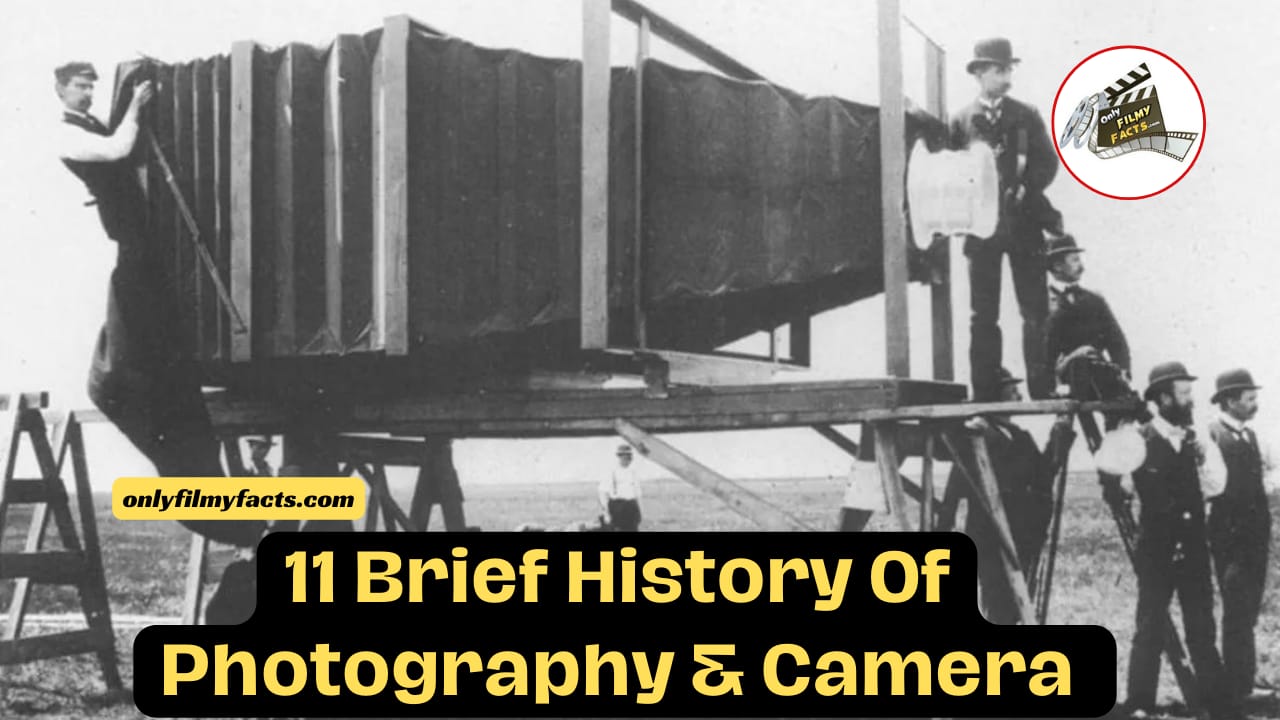The beginning History of photography started almost 200 years ago when the first prototype of a camera was developed from a plain box that took blurry photos. From primitive images to the sophisticated minicomputers found in modern DSLRs and smartphones, the history of photography has progressed.Here’s a brief look at the fascinating history of photography, including highlights & major developments of this scientific art form.
1. The Earliest Concept of Photography
The basic concept of photography has been around since about the 5th century B.C.E. The art was not created until an 11th century Iraqi scientist created a device known as the camera obscura.
Even then, the camera was only projecting images onto another surface; it was not really recording images. Even though the images could be traced to accurately draw real objects like buildings, they were also upside down.
The first camera obscura projected an image from outside the tent into the darkened space using a pinhole in the tent. Only in the seventeenth century—more precisely, in 1685—did German writer Johann Zahn imagine a portable prototype of the camera obscura.
2. Developing the First Permanent Images
Photography, as we know it today, began in the early 1800s in France when inventor Joseph Nicéphore Niépce created a prototype of a photographic camera in 1816.1 He used a portable a bitumen-coated pewter plate using a camera obscura to let light through. This is the first image ever captured that did not rapidly fade. It is attributed to him that the earliest surviving photograph of a view from his home’s window was taken in 1826.2.
Because of Niépce’s success, photography advanced quickly and led to several other experiments. In the middle to late 1800s, daguerreotypes, emulsion plates, and wet plates were developed nearly concurrently.
Photographers experimented with various chemicals and methods with each type of emulsion. These three played a pivotal role in the advancement of contemporary photography.
3. The Daguerreotype
A partnership between Niépce and Louis Jacques Mandé Daguerre resulted from his experiment. The result was the creation of the daguerreotype in 1837, defined as an image preserved as an object, or photograph, captured by an early photographic process.3 Here’s roughly how this camera worked:
- Before being exposed to light, a copper plate was coated with silver and exposed to iodine vapour.
- The early daguerreotypes needed to be exposed to light for up to 15 minutes in order to produce the image on the plate.
- Before emulsion plates took its place in the late 1850s, the daguerreotype was incredibly popular.
4. Emulsion Plates
Emulsion plates, or wet plates, were used between the 1830s and 1870s (before dry plates were invented in 1871).4 Wet plates were less expensive than daguerreotypes and required only two or three seconds of exposure time. Because of this, they were far more appropriate for portrait photography, which at the time was the most popular application of photography. The Civil War era produced a large number of wet plate photographs.
The Collodion process, an emulsion method, was employed in these wet plates as opposed to merely coating the image plate.Bellows were added to cameras during this period to aid in focus.
The ambrotype and the tintype were two popular varieties of emulsion plates. Whereas daguerreotypes used a copper plate, ambrotypes used a glass plate. Tinplates were used in tintypes. These plates needed to be developed quickly even though they were far more light-sensitive. Many photographers travelled in waggons that doubled as darkrooms, and they needed to have chemistry on hand.
5. History of Photography: Dry Plates
By 1871, photography had advanced significantly once more. Gelatin process photography, also referred to as dry plate photography and invented by Richard Maddox, is a technique that is far more practical and produces results that are almost as fast as wet plates. Charles Harper Bennett further refined the procedure in 1873 to produce higher-quality images.
Rather than being made on demand, these dry plates could be stored. This gave photographers a great deal more flexibility in terms of where and when they could take pictures. Additionally, the method made it possible to use smaller, handheld cameras, which later evolved into the film roll method. The first mechanically shuttered camera was created as exposure times shrank.
6. The Dawn of Roll Film
Photography was reserved for professionals and the extremely wealthy until businessman George Eastman founded the Eastman Dry Plate Company in 1881 (which was later reincorporated as the Eastman Kodak Company in 1892).
Eastman introduced a flexible roll of film in 1888 that eliminated the need to swap out solid plates on a regular basis. He was able to create a self-contained box camera with 100 film exposures thanks to this. The camera featured a single, tiny lens that was fixed in focus. Similar to modern disposable cameras, the user would take images and then send the camera back to the manufacturer so that the film could be developed and prints made. The camera kept innovating and evolving, and in the 1940s—a few years after Eastman’s passing—it became more widely available and more reasonably priced.
7. Fun Fact
In the 1930s, Henri Cartier-Bresson, known as the master of candid photography, used 35mm cameras to take spontaneous images of people and events, including European wartime efforts. Photographers made photographic history later in the decade, in 1939 and beyond, when they captured images from World War II. These images forever changed the face of photography as a news and communications tool.
:max_bytes(150000):strip_icc():format(webp)/vintage-camera-and-films--nancy--france-925819508-5c2d656246e0fb0001df1512.jpg)
8. The Magic of Instant Images
The original Polaroid camera, dubbed Model 95, was introduced in 1948 by inventor Edwin H. Land. A chemical process that developed film inside the camera in less than a minute made instant photos incredibly popular. The novelty of the Polaroid camera endured in popularity from the 1960s through the 1970s despite its high cost.
The Polaroid camera and film virtually disappeared in 2008 due to a number of issues, including the emergence of digital photography and the bankruptcy and sale of the Polaroid Corporation. However, by purchasing the last Polaroid film factory in 2018, the Impossible Project, formerly known as Polaroid Original and now just Polaroid, has miraculously brought the Polaroid brand back to life. The company’s goal is to introduce new camera generations while maintaining vintage Polaroid cameras and their artistic heritage.
:max_bytes(150000):strip_icc():format(webp)/stack-of-photographs--taken-for-vacation--saipan--78137492-5c2d748046e0fb0001fffffb.jpg)
9. Introduction of Advanced SLR Cameras
Even though Agfa invented colour film in the 1890s and into the 1940s in Europe, where the SLR (single lens reflex) camera first appeared, the technology wasn’t really practical until the 1950s. SLR-style cameras continued to advance and were the standard for the next thirty years.
:max_bytes(150000):strip_icc():format(webp)/young-woman-photographing-outdoors-928696746-5c2d70a146e0fb000169e702.jpg)
10. Innovations in Smarter Cameras
High-quality “point-and-shoot” compact film-based cameras were released in the late 1970s and early 1980s. With calculated shutter speed, aperture, and focus, these cameras managed images, freeing up photographers to focus on composition. The automatic cameras gained enormous popularity among amateur photographers. Professionals and serious amateurs continued to work with SLR cameras which allowed them to make custom and manual adjustments for more image control.
Around the same period of 1975, Eastman Kodak developed the very first digital camera that was big, bulky, and purely experimental.1213 However, it wouldn’t be until 1989 whenFirst fully digital camera to be sold commercially, the FUJIX DS-1P was created by Fujifilm (it featured a memory storage card instead of a detachable hard drive).
:max_bytes(150000):strip_icc():format(webp)/mother-taking-a-picture-of-baby-girl-88551810-5c2d6fdf46e0fb00017f4c1c.jpg)
11. Ushering in Digital Photography
Many manufacturers started releasing consumer and professional digital cameras in the 1980s and 1990s. The first DSLR (digital single lens reflex) camera to be sold commercially was the DCS 100, which Kodak introduced in 1991.
A newlywed father gained notoriety in 1997 when he set up his cell phone to capture a picture of the birth of his child.Japanese phone manufacturers began producing cell phones with cameras in 2000, and in the early 2000s, the idea quickly gained traction in the US. Since then, there has been a massive increase in the quality of cell phone cameras.
The history of photography is likely not over yet, but it is holding steady as basic point-and-shoot cameras take high-quality digital photos, most of us depend on smartphone cameras to capture our daily lives, and expert photographers still use DSLRs to produce high-quality pictures.

